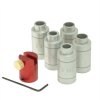JWFilips
Well-Known Member
Hi Folks,
I guess after loading all these years I should know what this means, however I have only ever done; Full length sizing, Partial neck sizing ( in FL die) and Neck Sizing ( in Neck sizing dies).
I guess I'm really not sure what the term "Slightly bumping back the neck" means or how it is achieved and why it is necessary?
Is it a method for not over working the brass?
I usually fl size..... then once fire formed......I then neck size for 6 to 8 times......
After that many firings I anneal the necks and FL resize again, and continue the above process
I guess after loading all these years I should know what this means, however I have only ever done; Full length sizing, Partial neck sizing ( in FL die) and Neck Sizing ( in Neck sizing dies).
I guess I'm really not sure what the term "Slightly bumping back the neck" means or how it is achieved and why it is necessary?
Is it a method for not over working the brass?
I usually fl size..... then once fire formed......I then neck size for 6 to 8 times......
After that many firings I anneal the necks and FL resize again, and continue the above process


